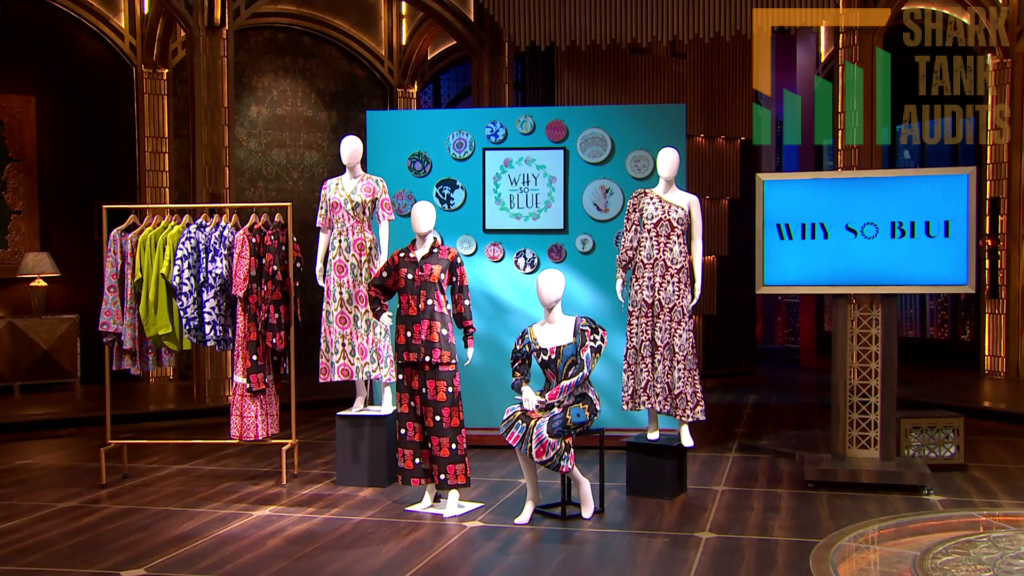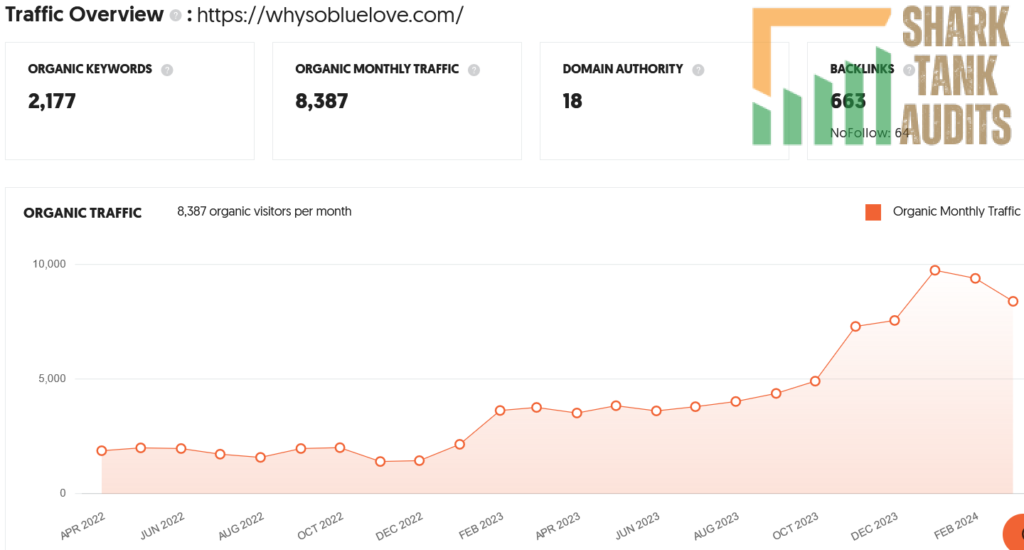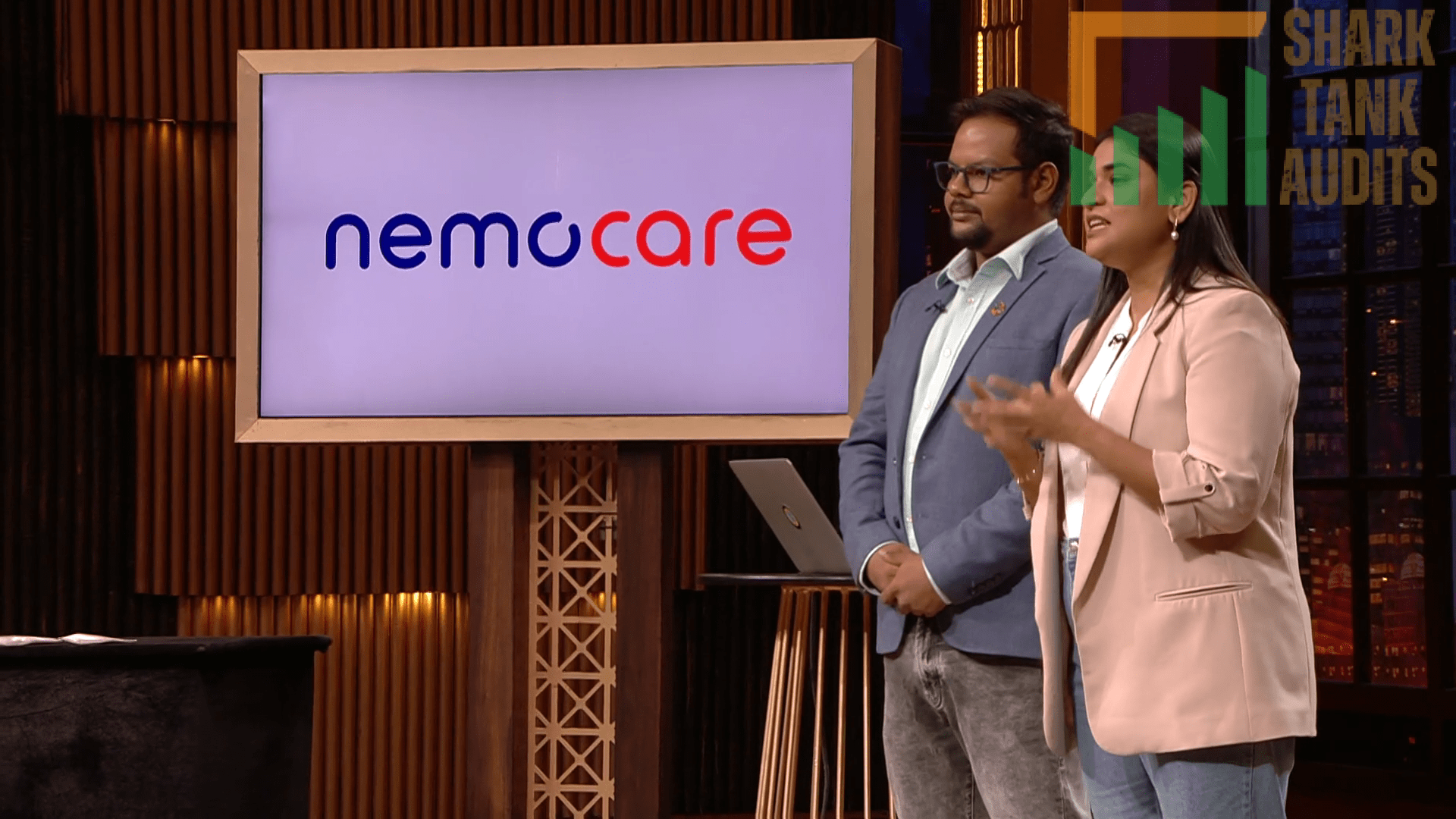WhySoBlue Shark Tank India Episode Review
Website Information:
- Website:- WhySoBlue
- Build on E-commerce Shopify
- SEO Improvement Needed
- ORGANIC TRAFFIC:- 8,387 organic visitors per month
Founders:
- Jaya Shivkumar and her daughter Shweta Shivkumar co-founded WhySoBlue in August 2015, establishing a women-led business focusing on casual and formal clothing.
- The business had humble beginnings in their living room, where Jaya stitched the initial collection and Shweta modeled the designs.
- With decades of experience in clothing stitching, Jaya contributed her expertise to the venture, while Shweta, a passionate plant lover, brought her inherited hobby into the mix.
- WhySoBlue upholds ethical employment practices and adopts zero-waste production methods in its operations.
- The brand prioritizes the use of soft, breathable fabrics sourced from various regions across the country, ensuring both quality and sustainability in its products.
Brand and Products:

- WhySoBlue – Specializes in vibrant printed and colorful outfits. Founded in 2015.
- WhySoBlue is an online fashion brand based in Mumbai, led by women, focusing on made-to-order clothing and lifestyle products.
- WhySoBlue offers a wide range of collections for men and women, including dresses and separates.
- The brand’s made-to-order approach allows for personalized and unique fashion items tailored to individual preferences.
- With a commitment to sustainability, WhySoBlue promotes conscious consumerism and eco-friendly practices in the fashion industry.
The Pitch:
- WhySoBlue presented its clothing line, emphasizing slow fashion and its environmental benefits.
- They showcased their co-ord sets (matching outfit pieces) and discussed the growing trend in India, especially for hot climates.
- The founders highlighted their unique prints and design techniques.
Sharks’ Concerns:
- The Sharks questioned the high price point of the clothing.
- They debated whether co-ord sets were appropriate for everyday wear outside the home.
- Some Sharks expressed concerns about the practicality of cotton co-ords in terms of wrinkling.
Shark Tank India Air Date:
- Season 3, Episode 43, 20 March 2024
The Deal:
- Despite reservations from most Sharks, Ritesh Agarwal offered Rs 40 lakh for 3% equity + Rs 35 lakh debt at 10% interest for 3 years.
- WhySoBlue accepted the offer.
Outcome:
- WhySoBlue secured investment despite concerns about their product and pricing strategy.

WhySoBlue Shark Tank Review Website Data
| Category | Description |
|---|---|
| Website Information | |
| Website | WhySoBlue |
| Platform | Shopify |
| SEO | Needs Improvement |
| Organic Traffic | 8,387 visitors per month |
| Founders and Mission | |
| Founders | Jaya Shivkumar & Shweta Shivkumar (mother-daughter duo) |
| Founded | August 2015 |
| Mission | Focus on casual and formal wear for men and women, prioritizing ethical practices and sustainability. |
| Brand and Products | |
| Category | Online fashion brand based in Mumbai |
| Target Audience | Men and women |
| Products | Dresses, separates, co-ord sets |
| USP | |
| * Made-to-order clothing for personalization and reduced waste | |
| * Commitment to sustainability and ethical practices | |
| * Vibrant prints and unique designs | |
| Business Potential in India | |
| Market Growth | Indian fashion industry to reach $350 billion by 202X (Source: IBEF, 2023) |
| Consumer Trend | Rising demand for sustainable fashion |
| Total Addressable Market (TAM) | |
| Target Audience | TAM Size (assuming 1% penetration & 475 million middle-class population) |
| TAM Size (assuming 1% penetration & 475 million middle class population) | Middle-class with disposable income |
| Ideal Target Audience and Demographics | |
| Age | 22-40 years old |
| Location | Tier 1 & Tier 2 Indian cities |
| Income | Middle to upper-middle class |
| Psychographics | Environmentally conscious, value ethical production, appreciate unique designs and personalization. |
| Marketing Strategy | |
| Content Marketing | |
| * Promote slow fashion and its environmental benefits | |
| * Showcase customer stories and personalized outfits | |
| * Partner with eco-conscious influencers | |
| Digital Marketing Strategy | |
| * Targeted Social Media Ads (Instagram & Facebook) | |
| * Search Engine Optimization (SEO) for relevant keywords | |
| * Influencer Marketing with micro-influencers | |
| Distribution Strategy | |
| * Continue E-commerce Focus (Shopify) | |
| * Explore Brand Partnerships (ethical fabric suppliers & retailers) | |
| * Consider Pop-Up Stores in major cities | |
| Advantages | |
| * Strong Brand Identity (established presence, unique designs, sustainability) | |
| * Growing Market (sustainable fashion) | |
| * Made-to-Order Model (reduced waste & personalization) | |
| * Existing Online Presence (website & organic traffic) | |
| Challenges | |
| * High Price Point (compared to fast fashion) | |
| * Educating Consumers (value of slow fashion & ethical practices) | |
| * Managing Growth (scaling production & quality control) | |
| Reasons for Success | |
| * Addressing a Growing Trend (sustainable fashion) | |
| * Differentiated Products (unique designs & personalization) | |
| * Strong Online Presence (foundation for digital marketing) | |
| Mitigation Strategies | |
| * Pricing Strategy (offer a range of price points) | |
| * Consumer Education (content about slow fashion & WhySoBlue’s practices) | |
| * Strategic Partnerships (potentially reduce production costs) | |
| Future Business Roadmap to Increase Valuation | |
| * Product Line Expansion (broader audience while maintaining core values) | |
| * Geographical Expansion (international markets) | |
| * Omnichannel Strategy (flagship stores to complement online presence) | |
| * Technology Integration (personalization & streamline operations) | |
| * Data Analytics (understand buying behavior & refine marketing) | |
| * Social Responsibility Initiatives (strengthen brand purpose) |
WhySoBlue: Building a Sustainable and Colorful Fashion Brand

Brand and Products:
- Category: Online fashion brand based in Mumbai
- Target Audience: Men and women
- Products: Dresses, separates, co-ord sets (matching outfit pieces)
- USP (Unique Selling Proposition):
- Made-to-order clothing for personalization and reduced waste
- Commitment to sustainability and ethical practices
- Vibrant prints and unique designs
Business Potential in India:
- Growing Indian Fashion Market: The Indian fashion industry is expected to reach $350 billion by 2 (Source: IBEF, 2023).
- Rising Demand for Sustainable Fashion: Consumers are increasingly conscious of environmental impact, creating a market for sustainable brands like WhySoBlue.
Total Addressable Market (TAM):
- Target Audience: Considering both men’s and women’s clothing, the TAM can be estimated as a significant portion of India’s middle class with disposable income.
- Assuming a TAM penetration of 1%, with an estimated Indian middle-class population of 475 million (Source: World Bank, 2023), the TAM is approximately Rs. 23,750 crore.
Ideal Target Audience and Demographics:
- Age: 22-40 years old (young professionals, fashion-conscious individuals)
- Location: Tier 1 & Tier 2 Indian cities (higher disposable income)
- Income: Middle to upper-middle class (disposable income for sustainable fashion choices)
- Psychographics: Environmentally conscious, value ethical production, appreciate unique designs and personalization.
Marketing Strategy:
Content Marketing:
- Create blog posts promoting slow fashion and its environmental benefits.
- Showcase customer stories and testimonials featuring personalized outfits.
- Partner with eco-conscious influencers to promote WhySoBlue’s sustainable practices.
Digital Marketing Strategy:
- Targeted Social Media Ads: Utilize Instagram and Facebook Ads to reach the ideal target audience based on demographics and interests.
- Search Engine Optimization (SEO): Optimize website content for relevant keywords like “sustainable clothing,” “made-to-order fashion,” and “co-ord sets.”
- Influencer Marketing: Collaborate with micro-influencers in the fashion and sustainability space to promote WhySoBlue’s products.
Distribution Strategy:
- Continue E-commerce Focus: Enhance the Shopify platform for a seamless online shopping experience.
- Explore Brand Partnerships: Collaborate with ethical fabric suppliers and eco-conscious retailers for wider reach.
- Consider Pop-Up Stores: Organize temporary retail experiences in major cities to create brand awareness and engagement.
Advantages:
- Strong Brand Identity: Established presence, unique designs, and commitment to sustainability.
- Growing Market: Capitalizes on the rising demand for sustainable fashion in India.
- Made-to-Order Model: Reduces waste and allows for personalization, increasing customer satisfaction.
- Existing Online Presence: An established website with organic traffic lays the groundwork for further digital marketing efforts.
Challenges:
- High Price Point: This may deter some customers, especially considering competition from fast fashion brands.
- Educating Consumers: Spreading awareness about the value proposition of slow fashion and ethical practices.
- Managing Growth: Scaling production and maintaining quality control with a made-to-order model.
Reasons for Success:
- Addressing a Growing Trend: Aligns with the growing consumer interest in sustainable fashion.
- Differentiated Products: Unique designs and personalization options set WhySoBlue apart from competitors.
- Strong Online Presence: Existing website and organic traffic provide a solid foundation for growth.
Mitigation Strategies:
- Pricing Strategy: Offer a range of products at different price points to cater to a wider audience.
- Consumer Education: Develop content that educates customers about the environmental benefits of slow fashion and WhySoBlue’s ethical practices.
- Strategic Partnerships: Collaborate with sustainable fabric suppliers to potentially reduce production costs.
Future Business Roadmap to Increase Valuation:
- Product Line Expansion: Introduce new collections catering to a broader audience while maintaining core values.
- Geographical Expansion: Explore international markets with a growing appreciation for sustainable fashion.
- Omnichannel Strategy: Consider flagship stores in major cities to complement the online presence.
- Technology Integration: Utilize technology to streamline operations and personalize the customer experience (e.g., virtual try-on tools, size recommendations).
- Data Analytics: Leverage website traffic and customer data to understand buying behavior and refine marketing strategies.
- Social Responsibility Initiatives: Partner with environmental NGOs or support sustainable cotton farming practices to strengthen brand purpose.
By implementing these strategies, WhySoBlue can solidify its position as a leader in India’s sustainable fashion movement. The brand’s commitment to vibrant designs, ethical practices, and environmental consciousness will resonate with a growing segment of eco-conscious consumers, ultimately leading to increased brand valuation.



